Genus Tetramorium species-groups - Part 2
| The Ants of
Africa Genus Tetramorium species-groups - Part 2 |
|
| Tetramorium Introduction |
DIV2
Species groups
Part 2 - former Xiphomyrmex
![]()
Species in the T. weitzeckeri species
group of Hita Garcia et al
(2010c). Kindly sent to me by Francisco Hita Garcia (November 2010).
Garcia, F. H., Fischer, G. & Peters, M. K. 2010c. Taxonomy of the Tetramorium weitzeckeri species
group (Hymenoptera: Formicidae) in the Afrotropical zoogeographical
region. Zootaxa, 2704:, 1-90. source pdf
(purchase only) * = new species in Garcia et al.
Tetramorium edouardi complex - petiole node always high nodiform
Tetramorium muralti complex - antennal scrobe well developed and deep with a distinct margin all round
Tetramorium
weitzeckeri complex -
well developed sculpturation
on head, at least seven rugae between frontal carinae
| Most with simple erect hairs, a few with bizarre pilosity or without erect hairs, none with multifid hairs Tetramorium s.s. | |||
11-segmented
antennae (Xiphomyrmex)  Otherwise |
|||
| weitzeckeri-group | Petiole
squamiform or at least a high narrow node in profile Otherwise  next species group
next species group |
||
| . | Scrobes
no more than weakly developed  |
||
| Complex-A | Mandibles unsculptured, well developed scrobes - muralti complex | ||
| 03 | Strongly
bicoloured, head & gaster black, alitrunk & appendages clear
pale yellow; TL 2.1-2.3 mm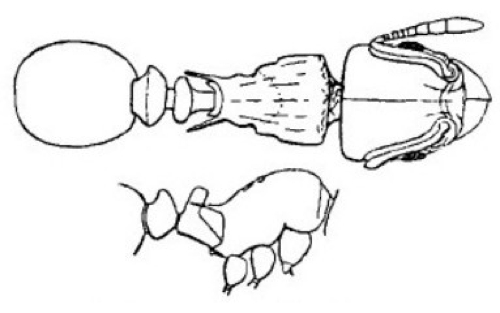 |
. | . |
| . |  |
Tetramorium flavithorax | West Africa |
| . | Unicolourous | . | . |
| . | Alitrunk dorsum with 3-7 well developed longitudinal rugae | . | . |
| NA | Antennal
scape short (SI 65–70); petiolar node squamiform, strongly transverse
and thin, in dorsal view between 2.5 to 3 times wider than long (DPeI
257–300); dorsum of mesosoma usually with 3, rarely 4, strong
longitudinal rugae medially
|
Tetramorium trirugosum | Cameroun & Gabon |
| NA | Antennal scape of moderate size
(SI 74–81); petiolar node thickly squamiform, in dorsal view either
less than twice as wide as long or only faintly more (DPeI 179–211);
dorsum of mesosoma with 6 or more longitudinal rugae 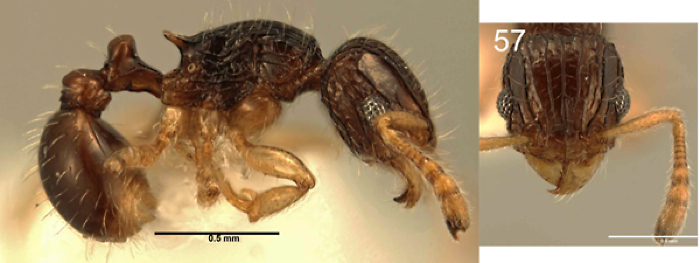 |
Tetramorium intermedium | Ghana |
| . | Alitrunk dorsum with no more than weak
partial longitudinal rugae |
. | . |
| . | Anterior margin of clypeus uninterrupted and convex | . | . |
| 05 | Head
with three long frontal carinae, frontal carinae continuing right
around to form a posterior margin to the antennal scrobe; TL 2.1-2.3
mm; uniform blackish-brown (the queen has a wider postpetiole than the
worker) |
Tetramorium muralti | West Africa & Congo Basin |
| NA | Head with only median frontal carina running to occiput; TL 2.3-3.3 mm; uniform dark brown to black | . | . |
| . |  |
Tetramorium susannae | West Africa & Congo Basin |
| . | Anterior margin of clypeus with a distinct median impression | . | . |
| NA | Metanotal
groove impressed(Fig. 8A); postpetiole in lateral view strongly rounded
dorsally and relatively low, only 1.25 times higher than long (LPpI
77–83), in dorsal view usually less than 1.5 times wider than long
(DPpI 143– 151) 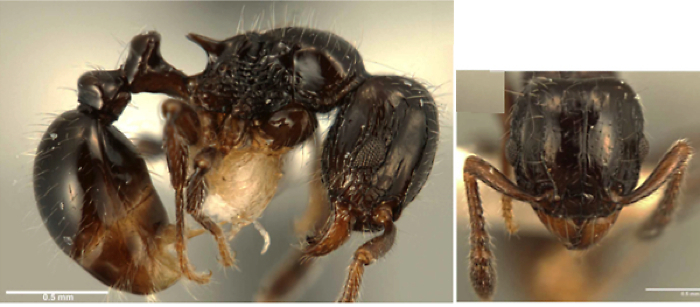
|
Tetramorium kakamega | Kenya |
| 05 | Petiolar
node moderately
squamiform, in dorsal view distinctly above twice as wide as long (DPeI
225- 268); in Akengi, X.1913, leg. H.O Lang (MCZ, USNM) Akengi, X.1913,
leg. H.O Lang (MCZ, USNM) lateral view between 2.3 to 2.8 times higher
than long (LPeI 36–44); colour uniformly very dark brown to black (type damaged) |
. | . |
| . | 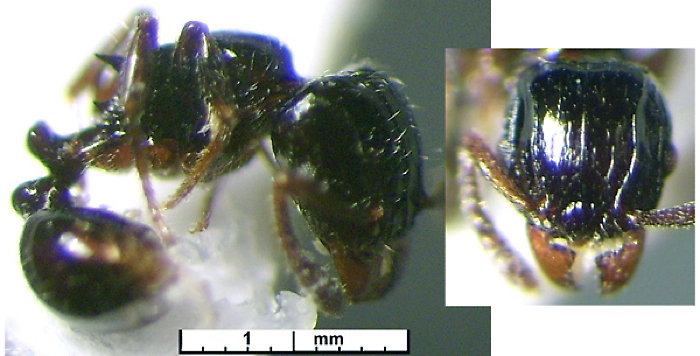 |
Tetramorium occidentale | West Africa & Congo Basin |
| NA | Petiolar
node thickly squamiform, in dorsal view less than twice as wide as long
(DPeI 188–196); in lateral view weakly above twice as high as
long (LPeI 47–50); colour uniformly reddish brown to brown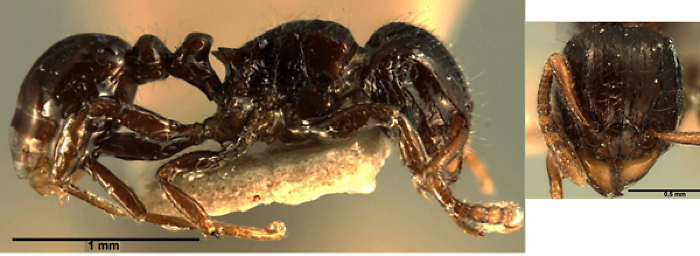 |
Tetramorium akengense | D.R. Congo |
| Complex-C | Well developed sculpturation on head, at least seven rugae between frontal carinae - weitzeckeri complex | ||
| - | No pilosity on first gastral tergite | ||
| 16 | Alitrunk with
numerous erect hairs; TL 3.4-3.6 mm; uniform brown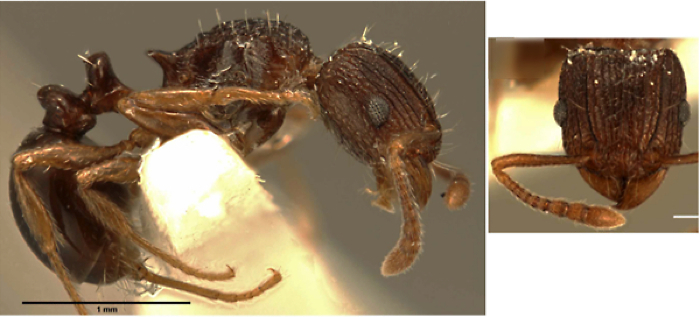 |
Tetramorium sepultum | S. Africa & Swaziland |
| - | Alitrunk dorsum with few or no erect hairs | ||
| NA | Alitrunk
dorsum with distinct reticulo-punctate ground sculpturation |
. | . |
| . |  |
Tetramorium bendai | Burundi |
| NA | Most of
alitrunk dorsum longitudinally rugose but lacking distinct ground
sculpturation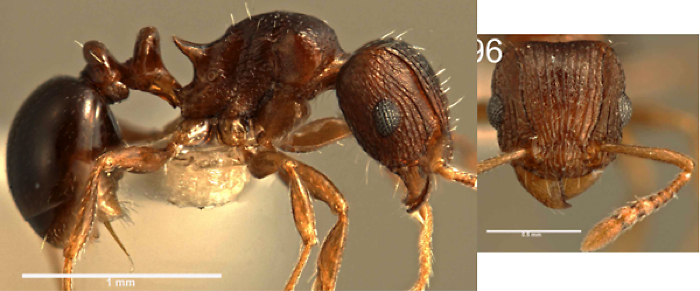 |
Tetramorium tanaense | Kenya |
| 16 | Alitrunk
dorsum with almost no sculpturation; TL 3.4-4.1 mm; light to dark brown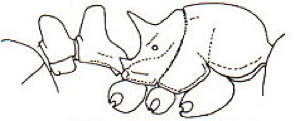 |
. | . |
| . | 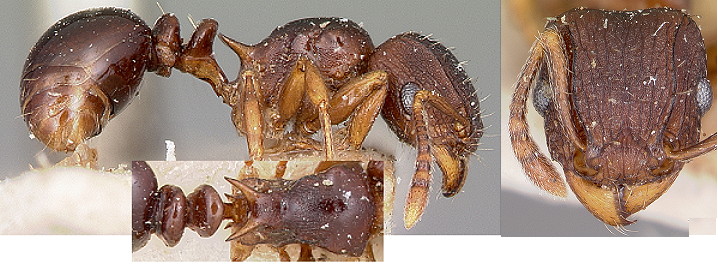 |
Tetramorium humbloti | East & southern Africa |
| - | Pilosity on first gastral tergite | ||
| 19 | Dorsum of head with conspicuous reticulate-punctate
groundsculpturation; propodealspines always long to very long (PSLI 28-
43) Postpetiole profile rounded nodiform; TL 2.9-3.7 mm; head with reticulo-punctate ground sculpture between longitudinal rugae; deep reddish brown to brown, gaster darker 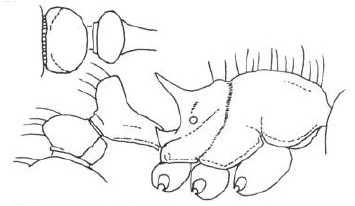 |
. | . |
| . |  |
Tetramorium guineense | West Africa & Congo Basin |
| . | Dorsum of head without conspicuous reticulo-punctate ground sculpturation. | . | . |
| NA | Distinctly
bicoloured; head and alitrunk orange to reddish-brown; pedicel and
gaster very dark brown to black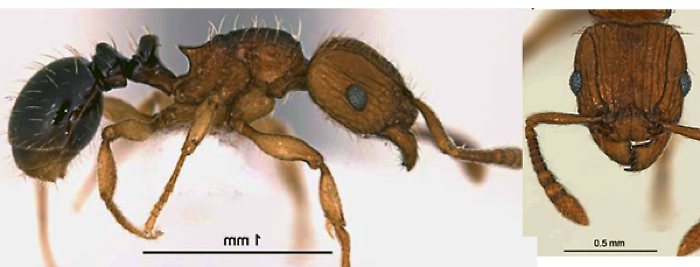 |
Tetramorium snellingi | CAR, Kenya, Uganda |
| NA | generally bicoloured with
alitrunk and pedicel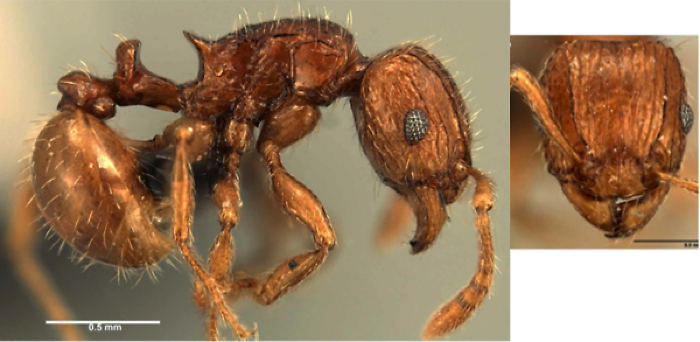 |
Tetramorium renae | São Tomé & Principe |
| 19 (part) | Both
segments of pedicel narrow squamate; TL 3.0-4.1 mm; head smooth and
shiny between longitudinal rugae; brown to blackish-brown, gaster darker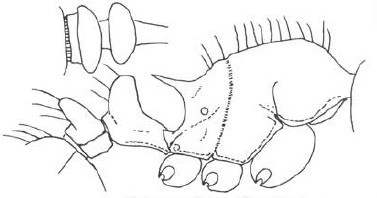 |
Bolton determined specimen | . |
| . | 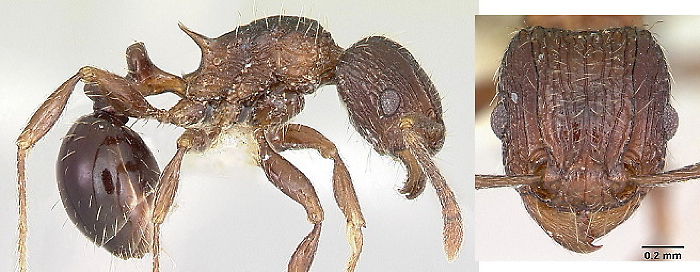 |
Tetramorium weitzeckeri | Eastern & southern Africa |
| NA | Smaller
species (HW 0.644–0.744, HL 0.678–0.761, SL 0.467–0.539, WL
0.778–0.911); propodeal spines moderate to long, triangular-elongate to
spinose, but never as long as above (PSLI 23- 29); rain
forest species |
Tetramorium boltoni | West Africa & Congo Basin (into East Africa forests) |
| Complex-B1 | Antennal scrobe no more than weakly developed and shallow petiole node high and nodiform - edouardi complex | ||
| NA | Alitrunk,
petiole, postpetiole, and first gastral tergite without standing hairs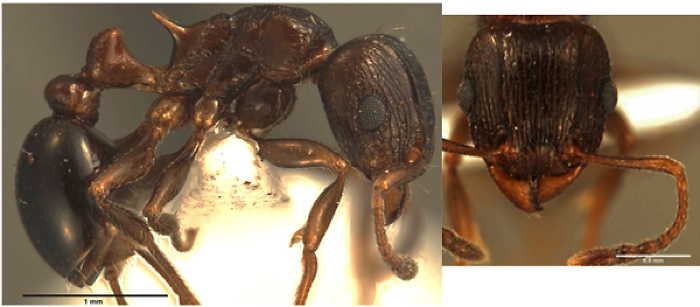 |
Tetramorium mkomazi | Tanzania |
| - | All erect hairs simple | ||
| - | Eyes relatively small (OI 21-22), bicoloured with gaster distinctly darker than rest | ||
| 07 | TL
3.7 mm; orange-brown, gaster much darker; mandibles smooth and shiny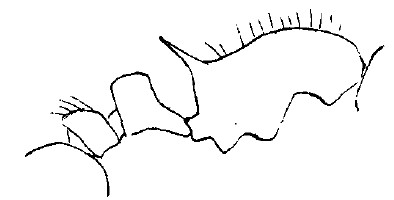 |
. | . |
| . | TL
3.7 mm; orange-brown, gaster much darker; mandibles smooth and shiny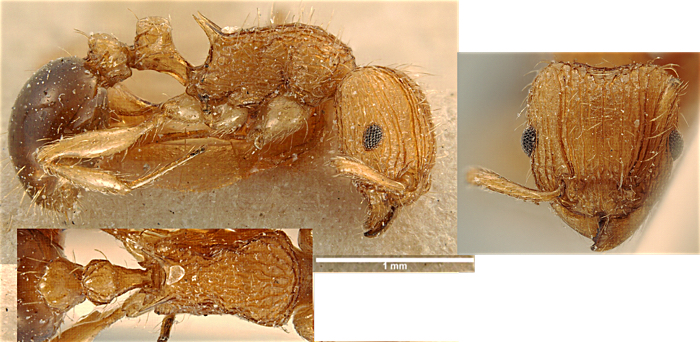 |
Tetramorium schoutedeni | Zaïre |
| NA | Mandibles with at least fine
longitudinal striations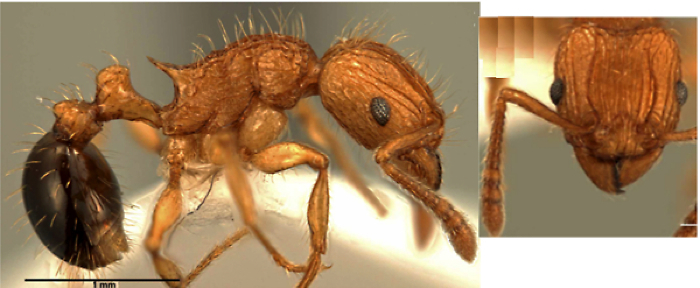 |
Tetramorium philippwagneri | Cameroun, Gabon & Zambia |
| - | Eyes relatively large, uniformly coloured | ||
| NA | Median
area of clypeus unsculptured, smooth and shiny |
Tetramorium robertsoni | Tanzania |
| 23 | Clypeus with distinct median
longitudinal ruga and 1 or 2 additional lateral rugae on each side Antennal scapes shorter (SI 76–83); eyes larger (OI 26–30); head relatively shorter (CI 90–95); in profile metanotal groove distinctly impressed; usually of very dark brown to nearly black colour 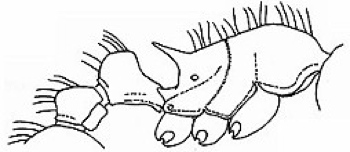 |
. | . |
| . |
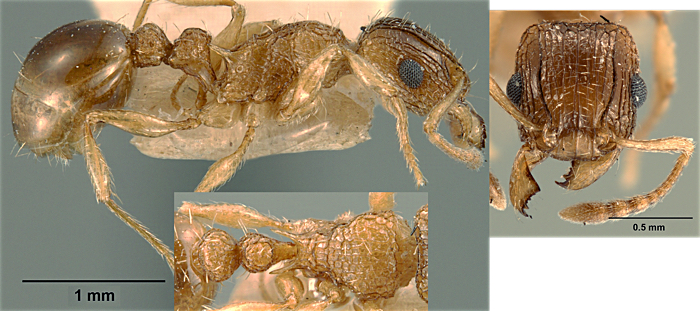 |
Tetramorium edouardi | Burundi, D.R. Congo, Ethiopia, Kenya, Tanzania, Uganda |
| NA | Clypeus
with distinct median longitudinal ruga and 1 or 2 additional lateral
rugae on each side; antennal scapes larger (SI 85–92); eyes smaller (OI
23–26); head
relatively longer (CI 87–91); in profile metanotal groove not
impressed; coloration reddish brown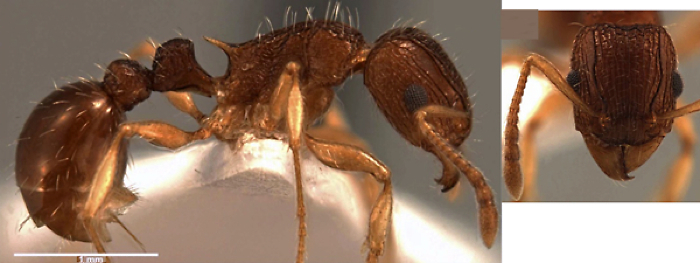 |
Tetramorium rubrum | Ivory
Coast, Ghana, Nigeria & Cameroun |
| Complex-B2 | Striate mandibles,
high narrow petiole node |
||
| - | Pilosity variably bizarre (i.e. not simple and relatively slender) | ||
| 17 | Unique
and bizarre pilosity: TL 3.4 mm; orange-brown, gaster blackish-brown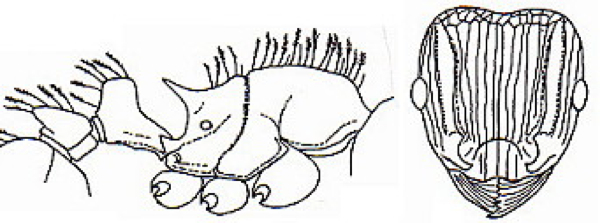 |
. | . |
| . |
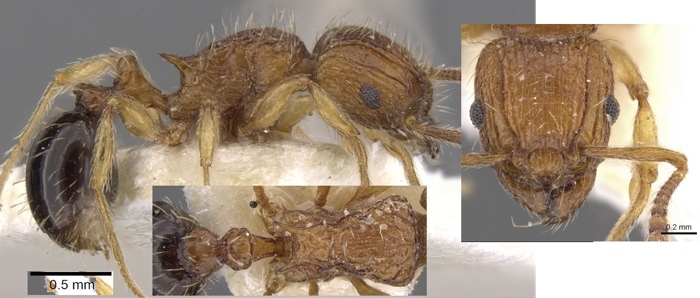 |
Tetramorium pinnipilum | Angola
& Kenya |
| 21 | First gastral tergite with
dorsoventrally flattened and reclinate hairs: TL 3.4-3.8 mm; medium to
dark-brown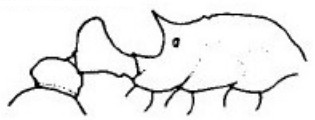 |
. | . |
| . | .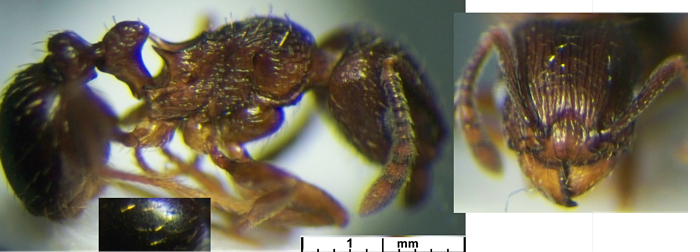 |
Tetramorium zonacaciae | Cameroun across to East African forests |
| 22 | With
distinctive clavate hairs; TL 3.6 mm; uniform mid-brown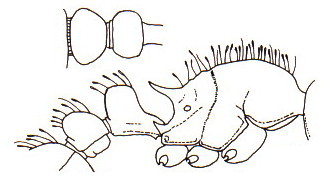 |
. | . |
| . |
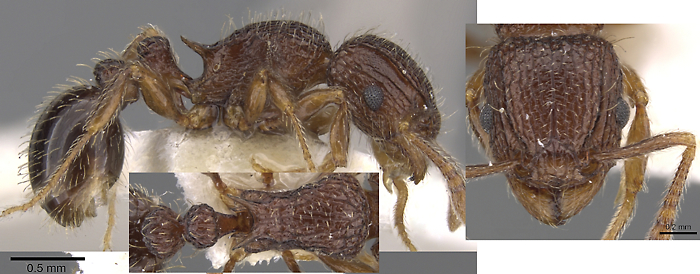 |
Tetramorium rogatum | Angola |
| tortuosum-group | Petiole
strongly nodiform; dorsal or outer surface of hind tibiae with long
projecting hairs Otherwise |
||
| NA | Antennal
scapes relatively short (SI 73 - 77); petiolar node in profile clearly
rectangular nodiform with anterodorsal and posterodorsal margins at
about same height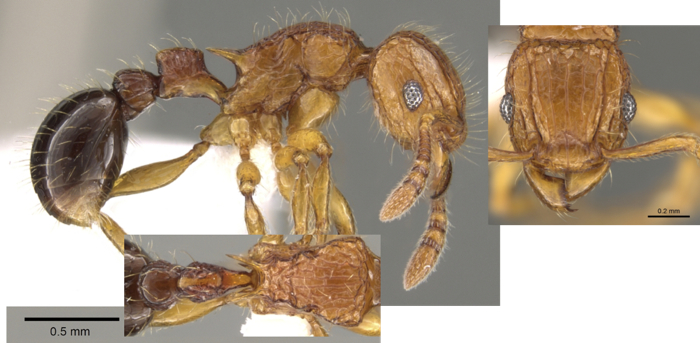 |
Tetramorium hecate | Cameroun
& Gabon |
| 20 | SI 80-86; mandibles coarsely
striate; eyes
smaller 0.23 X HW; petiole long, it and postpetiole sculptured; TL
3.7-4.2 mm; generally black, head reddish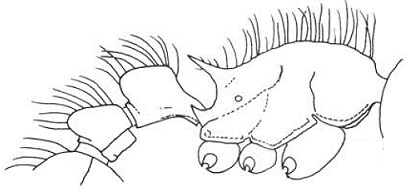 |
. | . |
| . | 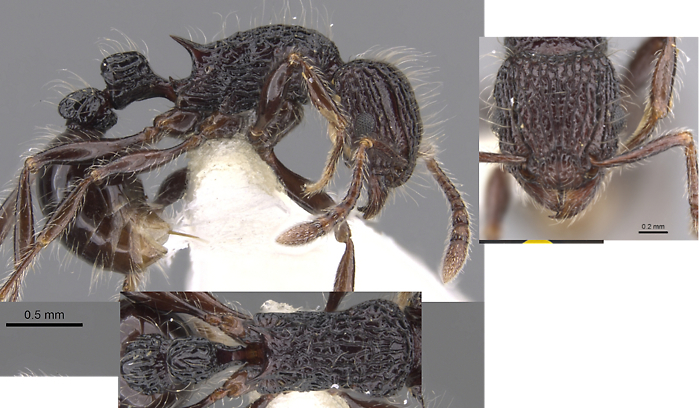 |
Tetramorium capillosum | Gabon |
| 10 | SI
80-86; mandibles
unsculptured; eyes about 0.27 X HW; pedicel unsculptured; TL 2.8 mm;
head and body bright orange-brown, gaster blackish-brown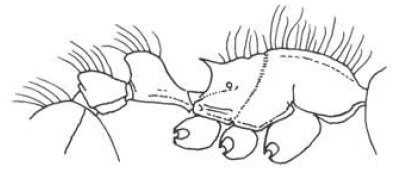 |
. | . |
| . |
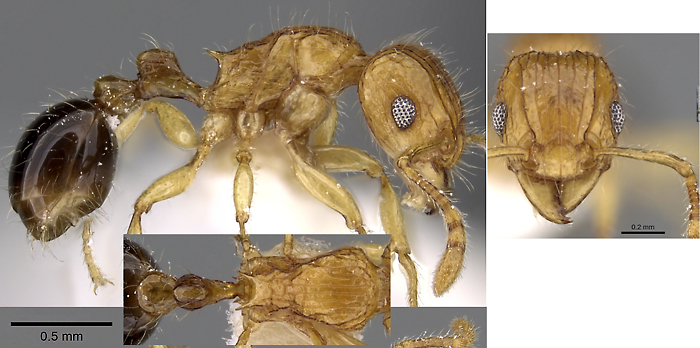 |
Tetramorium tabarum | Zaïre & Cameroun |
| angulinode-group | Petiole strongly nodiform; dorsal surface of hind tibiae only with fine pubescence; gaster with hairs in first tergite directed towards midline | ||
| 09 | Base
of first gastral tergite densely sculptured; TL 3.1-3.3 mm; dark
brown, gaster darker |
Tetramorium legone | Ghana
& Nigeria savannah nests in sandy soil |
| - | Base of first gastral tergite unsculptured | ||
| 11 | Alitrunk dorsum with dense coarse
puncturate sculpture and a dull surface; TL 3.5-3.7 mm; dark brown,
gaster black - note others matching the general features are orange
brown with a darker gaster |
. | . |
| . |  |
Tetramorium calinum | Ghana & Nigeria savannah/open forest nests in sandy soil |
| - | Alitrunk dorsum with rugulose sculpturation and a shiny surface | ||
| Propodeal spines short | |||
| 12 | Promesonotum only lightly rugose; pedicel dorsum
completely smooth and shiny; TL 2.1-2.3 mm; uniform blackish-brown to
black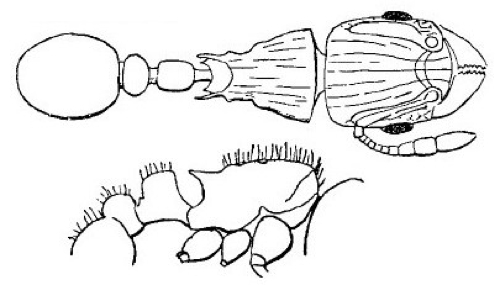 |
. | . |
| . | 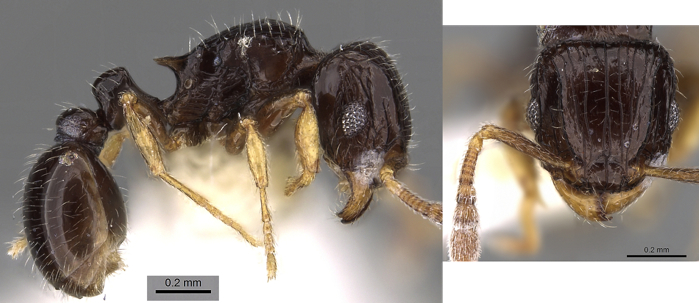 |
Tetramorium minisculum | West Africa & Congo Basin |
| - | Propodeal spines long | ||
| 14 | Postpetiole node much shorter
than that of petiole; postpetiole node smooth; TL 2.2-2.6 mm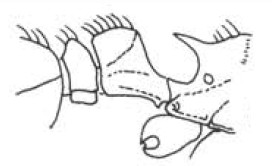 |
. | . |
| . |  |
Tetramorium chloe | Zimbabwe |
| - | Petiole and postpetiole nodes about the same length | ||
| - | TL no more than 2.4 mm | ||
| (14) | Without
any propodeal armature; postpetiole and petiole nodes about equal
length; postpetiole node faintly sculptured; TL 2.4 mm; mid-brown,
gaster blackish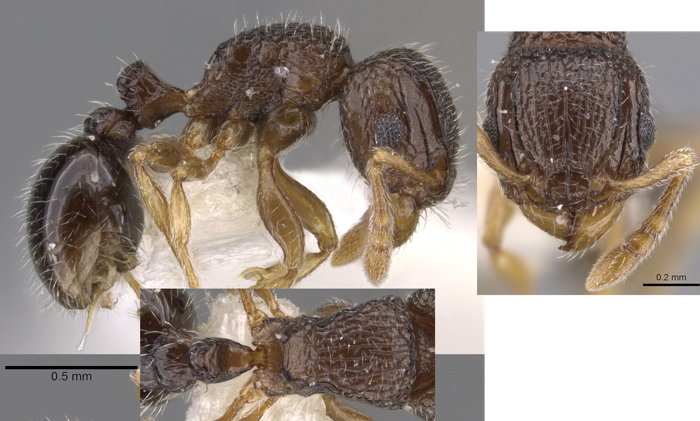 |
Tetramorium nullispinum | Nigeria |
| (14) | TL 2.3 mm; propodeal spines long,
acute and straight in profile; pedicel nodes reticulate-punctate;
overall shiny, ferruginous, dorsum of head and gaster dull (apparently
very similar to angulinode)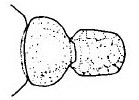 |
Tetramorium sudanense | South Sudan |
| - | TL at least 2.4 mm | ||
| - | NOTE - the diagnosis from here is confused due to an apparent mix up by Bolton (1980). Bolton described a new species T. zapyrum that appears to match the original Santschi (1910c) description of T. angulinode. As Bolton did not illustrate his zapyrum and made no explicit reference to Santschi's clear drawings of angulinode, this is difficult to unravel. it seems quite possible that zapyrum should be relegated to a junior synonym of the type angulinode. The form illustrated by Bolton appears better matched to what I separate as T. angulinode papyri. | ||
| 14 (13 zapyrum) | TL
2.3-2.9 mm, HL 0.75, HW 0.65, CI 87, SL 0.42, SI 65, PW 0.58; petiole
node in profile cuboid with a (near) flat dorsum and vertical anterior
and posterior faces, without any diagonal carina; postpetiole and
petiole nodes about equal length; postpetiole node sculptured; with
quite dense and very fine erect hairs; legs and antennae with decumbent
quite strong pubescence; dark brown; savannah and cleared forest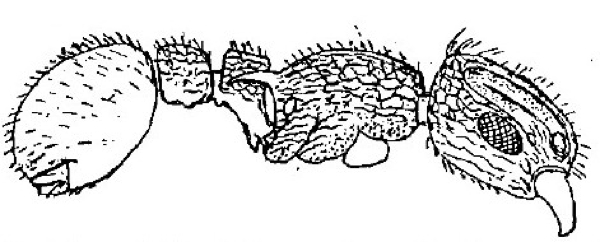 |
Santschi (1910c) type form (matched by Bolton description of Tetramorium zapyrum) | . |
| . |  |
Tetramorium angulinode | Panafrican |
| - | Pedicel segments weakly sculptured with shining spaces | ||
| (14) | TL
2.4 mm; both pedicel nodes with a shallowly convex dorsum in profile,
the petiole with a distinct diagonal carina from upper anterior to
lower posterior corners; postpetiole and petiole nodes quite weakly
sculptured with smooth areas; hind tibiae quite short and broad; legs
and antennae with minute pubescence; savannah and cleared forest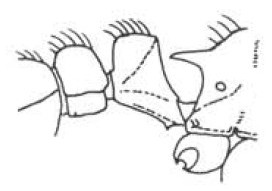 |
. | . |
| . | 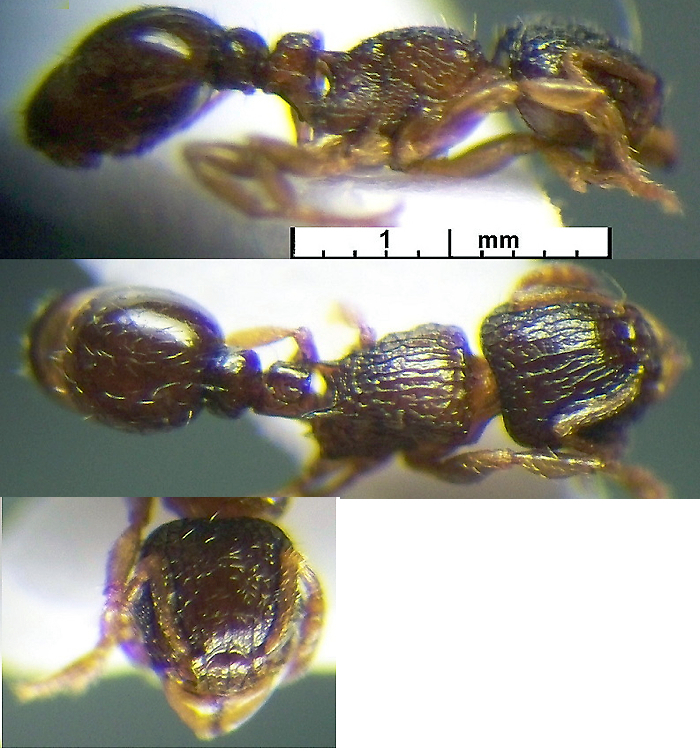 |
Tetramorium angulinode papyri | West Africa & Congo Basin |
| 13 | TL 2.7-3.2 mm, CI 100; petiole
weakly sculptured but with clear longitudinal rugae; postpetiole
slightly narrower then the petiole in profile but much wider when
viewed from above, it also has distinctly angular lower corners; hind
tibiae relatively short and broad dark brown, gaster blackish; forest
species, nests in wood on the ground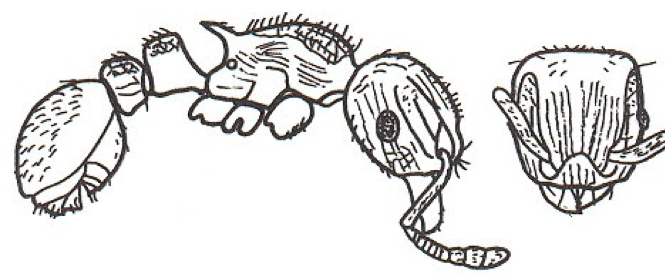 |
. | . |
| . | 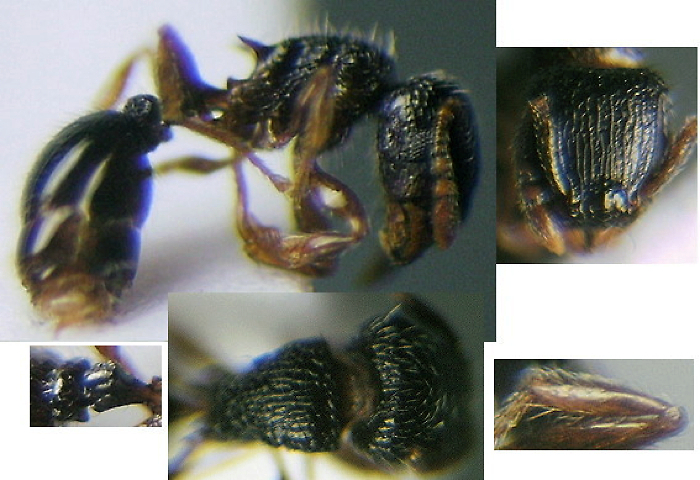 |
Tetramorium rugosum | Nigeria & Congo Basin - new species |
|
© 2007, 2008, 2011, 2013, 2014, 2016, 2017, 2018 - Brian Taylor
CBiol
FRSB FRES 11, Grazingfield, Wilford, Nottingham, NG11 7FN, U.K. |
href="tetramorium_groups_2.htm"